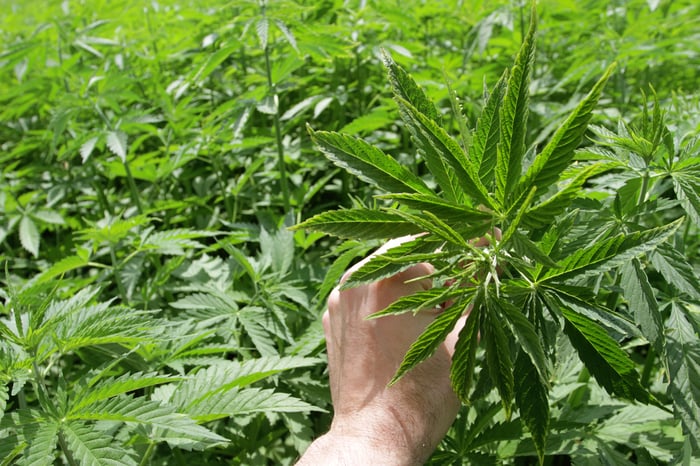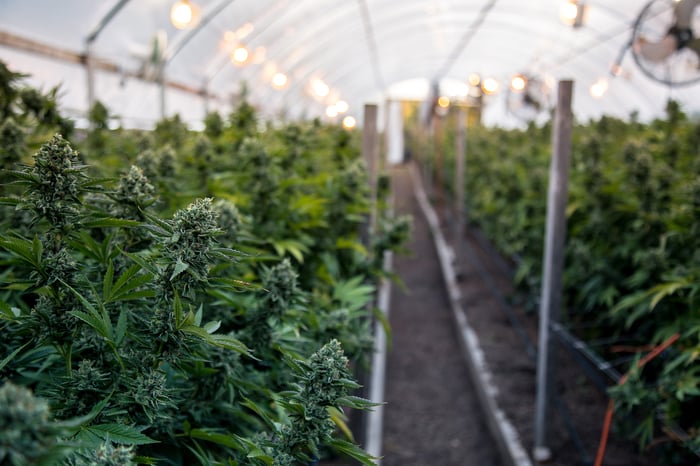As the year winds to a close, it's pretty evident that the cannabis industry had a groundbreaking year. This year, we witnessed Canada become the first industrialized country in the world to legalize recreational marijuana, opening the door to what should be billions of dollars in added annual sales by the beginning of the next decade.
We also witnessed the marijuana movement making waves in the United States, despite the federal government holding firm on the drug's scheduling. The U.S. Food and Drug Administration approved its very first cannabis-derived drug, and a handful of states legalized weed in some capacity. When 2019 begins, 32 states will have given the green light to medical marijuana, with 10 of those states also allowing adult-use pot.

Image source: Getty Images.
Surprise! These marijuana stocks should lose money in fiscal 2019
And yet, one of the biggest realizations of 2018 was that marijuana stocks performed miserably. Many ended the year down 30%, 40%, or lost well over half of their value. This drop can be correlated with a transformation in how Wall Street and investors think about marijuana stocks now that it's legal in Canada. In particular, with sales about to ramp up, earnings actually matter now.
As we head into 2019, sales should soar by a double- or triple-digit percentage, but this doesn't necessarily mean profits will follow. Quite a few big-name pot stocks aren't likely to earn money in fiscal 2019, despite a burgeoning North American marijuana industry.

Image source: Getty Images.
Canopy Growth
Although Canopy Growth (CGC -10.51%) is the largest publicly traded marijuana stock in the world by market cap, it has virtually no chance of producing an operating profit or adjusted per-share profit in fiscal 2019.
Canopy Growth is going to be working on a number of aspects of its business in 2019. It'll be looking to complete its capacity expansion projects, which, when licensed, should span 5.6 million square feet and offer somewhere around 500,000 kilograms in peak annual production. This should slot Canopy Growth in as the second-largest grower by annual output. The company already has 4.3 million square feet licensed by Health Canada.
Beyond just capacity expansion, Canopy Growth will be looking to expand its product portfolio, build up and market its existing brands, move into new international markets, and make acquisitions. As a reminder, Canopy Growth received $4 billion from Corona and Modelo beer maker Constellation Brands for what equates to a 37% equity stake in the company. Now cash-rich, Canopy will be spending liberally to improve the reach of its products.
With an Amazon-like approach to its early-stage growth strategy -- i.e., emphasizing sales growth and consumer reach over profitability -- losses are highly likely.

Image source: Getty Images.
MedMen Enterprises
Another popular pot stock likely to deliver significant losses on a per-share basis in fiscal 2019 is upscale dispensary and grow-farm operator MedMen Enterprises (MMNFF).
Having gone public via a reverse takeover in 2018, MedMen had been aiming for about 50 open retail dispensaries by 2020 (it has 14 right now). Of course, that was before it announced the largest U.S.-based deal in history: the $682 million deal to acquire PharmaCann. When complete, this purchase will double the number of states MedMen is operating to 12, increase its production/cultivation facilities to 13 from five, and boost the number of licensed retail locations to 66 from 48. In other words, it's a quick way for MedMen to boost its visibility in the U.S.
But understand that as MedMen works to open new locations and absorbs PharmaCann, the company's expenses will soar considerably faster than its sales. Even with sales per square foot topping that of Apple stores, it's difficult to see a scenario where a rapidly expanding MedMen can turn a recurring quarterly profit any earlier than 2021. As earnings come into focus, this looks to be a pot stock to avoid in the upcoming year.

Image source: Getty Images.
Tilray
One of the top-performing pot stocks, Tilray (TLRY), is also expected to lose a substantial amount of money in 2019.
Like Canopy Growth, Tilray is going to be busy working on numerous aspects of its business, including growing capacity, branding, medical cannabis research and development, portfolio expansion, international expansion, and perhaps even acquisitions. These will all cost a pretty penny, which'll push Tilray into the red for 2019.
But unlike Canopy Growth, Tilray is a bit behind with regard to capacity expansion based on some of its larger peers. When filing its S-1 prospectus with the Securities and Exchange Commission prior to its IPO, Tilray estimated the completion of 912,000 square feet of facilities by the end of the calendar year, of which just over 850,000 square feet would be devoted to growing cannabis. At peak potential, this may produce around 80,000 kilograms, but is a far cry from the 255,000 kilograms to 700,000 kilograms that could be respectively produced by the three top growers by peak annual output. Tilray has close to 3 million square feet of capacity expansion potential, and it'll be interesting to see if it utilizes this space in 2019 or if it takes the faster route and acquires capacity. Either way, this bottle rocket of a pot stock isn't going to turn a profit in the upcoming year.

Image source: GW Pharmaceuticals.
GW Pharmaceuticals
Finally, don't look for the premier cannabinoid-based drugmaker, GW Pharmaceuticals (GWPH), to generate any green in 2019.
This was a big year for GW Pharmaceuticals, with the Food and Drug Administration approving its cannabidiol (CBD)-based oral solution known as Epidiolex for two rare types of childhood-onset epilepsy. CBD is the nonpsychoactive component of the cannabis plant best known for its perceived medical benefits. Given the least restrictive classification possible (Schedule V) by the U.S. Drug Enforcement Agency, GW Pharmaceuticals launched its lead drug in early November.
The thing is, it takes quite a bit of time and marketing before a newly launched therapy finds success. Drug developers need to work with insurers to find coverage for their drug. In this instance, there are no FDA-approved therapies to treat Dravet syndrome, other than Epidiolex, so you'd think coverage would be easy to come by. However, with a $32,500 list price, it may not be as much of a slam-dunk as investors might think.
Furthermore, competition to Epidiolex may be on the horizon, limiting the drugs' potential in Dravet syndrome shortly after it launches out of the gate. Long story short, expect steep per-share losses in fiscal 2019 from GW Pharmaceuticals, even with a rapid rise in revenue.





